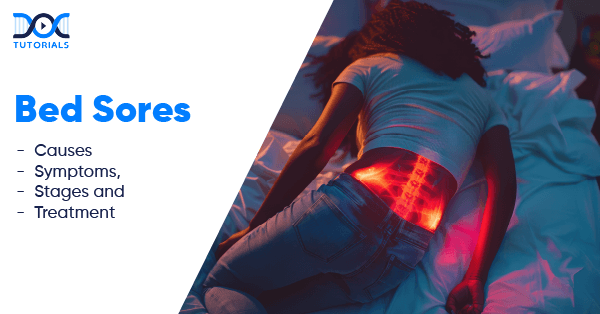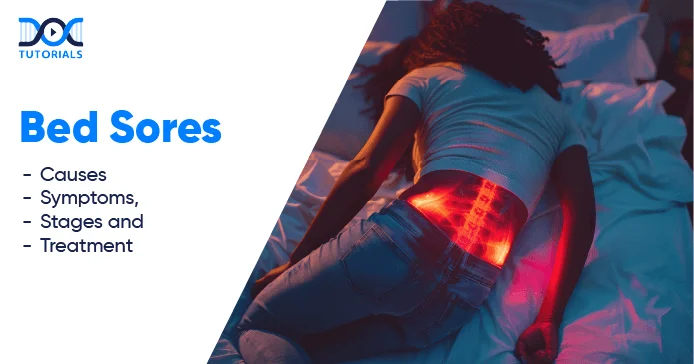Bed Sores: Causes, Symptoms, Stages, and Treatment

Bed sores, also known as pressure ulcers or decubitus ulcers, develop in thousands of patients, mainly when they receive hospital and home care. The healthcare challenge of bed sores is significant because India faces a rising number of older people and chronic conditions that affect wound healing rates, especially in urban areas and rural regions.
Studies conducted in Indian hospitals show that bedridden patients experience a prevalence between 7% and 12% of pressure ulcers, but the rates are higher in healthcare facilities with limited resources. This guide provides information about bed sores, their causes, symptoms, risk factors, diagnostic methods, treatment strategies, and complications.
What are Bed Sores?
Pressure injuries, or bed sores, form when continuous pressure damages the skin layer and underlying tissues at bony body locations such as the sacrum, heels, elbows, and shoulder blades. Pressure ulcers often occur in immobile people, especially older people, critically ill patients, and those with neurological impairments, reducing their ability to move or sense pain.
Pressure injuries form slowly when persistent pressure cuts off blood supply to the skin and surrounding tissue, creating a series of fatal tissue breakdowns. Patients experience varying levels of tissue injury, starting with skin discolouration and progressing to severe wounds that reveal both muscle tissue and bones.
The formation of pressure injuries remains preventable with proper surface support and frequent patient repositioning. Bed sores can result in severe medical complications, prolonging hospital stays and creating opportunities for severe infections and sepsis, so identification and prevention strategies become essential aspects of complete medical care.
Stages of Bed Sores
Each bed sore stage reflects different tissue damage depths that need specific achievable interventions for treatment.
- Stage 1: At first, you will notice non-blanching erythema and persistent redness or discolouration on intact skin that does not fade when you press it. This may occur along with warmth, tenderness or altered skin firmness.
- Stage 2: Then, skin tissue breaches the epidermis by forming shallow open ulcers and fluid-filled blisters, and showing inflammation across the wound area.
- Stage 3: Slowly, a crater-like wound penetrates the full skin depth into the subcutaneous tissue, revealing yellowish subcutaneous fat layers without reaching muscle, tendon, or bone structures.
- Stage 4: Stage 4 ulcers are severe since they surpass all soft tissue layers to reveal muscle, tendon or bone structures with possible tunnelling into surrounding tissue and slough or eschar growth.
Additional categories include “Unstageable” ulcers with wound surfaces hidden by slough or eschar and “Deep Tissue Injuries” that present with purple or maroon-coloured intact skin demonstrating subcutaneous tissue damage.
Proper intervention delays stage progression, but sometimes, a rapid advancement happens within hours and leads to life-threatening medical emergencies if not intervened.
Treatment Options for Bed Sores
Bed sores treatment requires complex interventions involving multiple healthcare experts who implement wound care practices alongside pressure distribution methods, nutritional feeding, and infection-preventive strategies.
- Pressure Relief
Medical beds utilising air-fluidized components and alternating pressure systems redistribute weight to protect tissue from additional damage. Routine position changes should occur every 2-3 hours by applying a 30-degree tilt to distribute pressure across vulnerable skin areas.
- Wound Care
The saline solution effectively cleans debris from delicate tissue while causing no harm to the tissue structure. Stage-appropriate dressing types, such as hydrocolloids for minimal ulcers, alginates for exudative wounds, hydrogels for dry wounds, and foam dressings for protective purposes, create the best conditions for wound healing through their specific functions.
- Debridement
The healing process speeds up when physicians remove dead tissue from wounds to clear the way for tissue growth. The four debridement methods include surgical removal through sharp debridement, topical enzyme debridement, self-digestive debridement through autolytic debridement methods, and mechanical debridement approaches by wet-to-dry dressings or irrigation.
- Infection Management
For clinical infections, doctor-prescribed systemic antibiotics must be administered following wound culture analysis. Silver-impregnated dressings maintain a controlled amount of microbes in colonised wounds.
Treating infections accelerates the healing process and avoids complications such as sepsis (an improper immune system response to an infection)and osteomyelitis (inflammation or swelling of bones).
- Surgical Intervention
Skin grafts with direct closure and flap procedures become necessary options after standard care fails for advanced wound conditions. Before surgical procedures, patients need to exhibit proper nutrition levels alongside controlled medical conditions. Post-operative care incorporates skin pressure management and the surveillance of affected areas to avoid wound relapse.
- Nutritional Support
Protein intake of 1.2-1.5 g/kg body weight daily, adequate hydration, and supplementation with vitamins C, A, and zinc support are necessary for tissue repair. This nutritional assessment with intervention needs to form an essential part of the treatment plan since it supports explicitly malnourished patients.
Prevention of Bed Sores
The most efficient strategy to control pressure ulcers is prevention, which achieves dual benefits by cutting healthcare expenses and reducing patient discomfort. Effective pressure ulcer prevention strategies establish their base in healthcare facilities and home environments.
- Regular Repositioning
Individuals in bed must change their positions every two hours, while individuals sitting need position changes every fifteen to thirty minutes. A better approach to reducing friction involves using the 30-degree sloped posture rather than 90-degree movements. Bony prominences should always remain free of contact through pillows or foam wedges.
- Skin Care
A daily examination of the skin surface should focus on bony protrusions. When experiencing incontinence, it is crucial to clean the affected area using gentle cleansing agents. Moisturising creams should be applied to dry skin areas, while barrier creams should protect skin that tends to get wet. Proper lifting methods should be used to reduce transfer friction.
- Nutrition and Hydration
Patients must eat enough proteins and drink adequate fluids. They should also supplement with vitamins C, zinc, and iron when needed. Healthcare providers must test patients who demonstrate signs of nutritional deficiency for their condition.
- Support Surfaces
Patients should use high-specification foam mattresses as they perform better than standard ones. Dynamic air mattresses provide suitable support for patients at high risk of pressure ulcers. Specialised cushions must be used by patients who require seated positions. Pillows under the calves should be used to keep heels elevated completely.
- Assessment and Education
Regular evaluations should use recognised risk assessment tools. Individualised care plans should be created. Patient and caregiver education and staff training should be provided for skin precursors and the preventative methods they should follow.
FAQs About Bed Sores
- What is the most suitable ointment to treat bed sores?
Bedsore treatment ointments commonly include Cadexomer-iodine paste, hydrogels, Silver Sulfadiazine cream, and Phenytoin Topical ointment.
- What is the best natural remedy for bed sores?
Effective treatment of minor sores through regular body repositioning and skin care, along with natural remedies, including aloe vera, honey, and coconut oil, provides effective healing.
- What deficiency causes bed sores?
The presence of vitamin D deficiency stands as a risk factor for developing pressure ulcers or bedsores.
- Is saltwater good for bed sores?
Saline solution or salt water is a standard treatment for bedsores (pressure ulcers) since it removes necrotic tissue while fighting infections.
- What antibiotics are used for bedsores?
Antibiotics effectively treat bedsores. Some of them include silver sulfadiazine, mupirocin, amoxicillin-potassium clavulanate, imipenem/cilastatin, and meropenem.
Conclusion
Bed sores can be prevented with proper nursing attention, scheduled body movements, and timely medical intervention. An appropriate understanding of stages and suitable treatments can lead to better patient results and improved comfort.
The most successful strategies for combating such complex skin wounds involve pressure reduction efforts and skin maintenance. Stay tuned for more insights into forensic sciences and medical concepts from our expert content on DocTutorials!
Latest Blogs
-

NEET PG Exam 2025- Date, Pattern, Marking Scheme, Subject Wise Weightage, and Exam Mode
NEET PG Exam 2025 is the ultimate gateway for medical graduates aspiring to pursue postgraduate courses in medicine, including MD,…
-

INI CET Exam 2025: Your Roadmap to Success – Key Topics, Strategies, and Lessons from Last Year’s Papers
The INI CET exam is more than just a test; it’s a significant milestone for many medical students aiming to…
-

INI CET Exam Success: Previous Year Question Papers & Ultimate Guide – INI CET PYQ
One can feel overwhelmed while preparing for the INI CET (Institute of National Importance Combined Entrance Test). A vast syllabus,…





